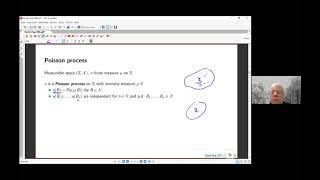
Fixed Effects and Random Effects
Brief overview in plain English of the differences between the types of effects. Problems with each model and how to overcome them.
From playlist Experimental Design

Statistics - 5.3 The Poisson Distribution
The Poisson distribution is used when we know a mean number of successes to expect in a given interval. We will learn what values we need to know and how to calculate the results for probabilities of exactly one value or for cumulative values. Power Point: https://bellevueuniversity-my
From playlist Applied Statistics (Entire Course)

Expectation of a Poisson random variable
How to compute the expectation of a Poisson random variable.
From playlist Probability Theory

Short Introduction to the Poisson Distribution
Please Subscribe here, thank you!!! https://goo.gl/JQ8Nys Short Introduction to the Poisson Distribution
From playlist Statistics

By popular request, this is a version of the video https://youtu.be/HfCQdFpNeLQ showing a linear wave hitting obstacles distributed according to a Poisson point process, but with a color scheme showing only the wave height. A Poisson point process is the most random distribution of points
From playlist Mangroves vs tsunamis (sort of)

Statistics: Intro to the Poisson Distribution and Probabilities on the TI-84
This video defines a Poisson distribution and then shows how to find Poisson distribution probabilities on the TI-84.
From playlist Geometric Probability Distribution

The Poisson is a classic distribution used in operational risk. It often fits (describes) random variables over time intervals. For example, it might try to characterize the number of low severity, high frequency (HFLS) loss events over a month or a year. It is a discrete function that con
From playlist Statistics: Distributions

Definition of a Poisson distribution and a solved example of the formula. 00:00 What is a Poisson distribution? 02:39 Poisson distribution formula 03:10 Solved example 04:22 Poisson distribution vs. binomial distribution
From playlist Probability Distributions

Poisson Distribution EXPLAINED!
http://www.zstatistics.com/videos/ 0:25 Quick rundown 2:15 Assumptions underlying the Poisson distribution 3:08 Probability Mass Function calculation 5:14 Cumulative Distribution Function calculation 6:29 Visualisation of the Poisson distribution 7:25 Practice QUESTION!
From playlist Distributions (10 videos)

Saharon Rosset: "Statistical modeling of mutational processes"
Computational Genomics Summer Institute 2017 Tutorial: "Statistical modeling of mutational processes" Saharon Rosset, Tel Aviv University Institute for Pure and Applied Mathematics, UCLA July 14, 2017 For more information: http://computationalgenomics.bioinformatics.ucla.edu/
From playlist Computational Genomics Summer Institute 2017

Mutation, Selection and Evolutionary Rescue in Simple Phenotype....(Lecture 1) by Guillaume Martin
PROGRAM FIFTH BANGALORE SCHOOL ON POPULATION GENETICS AND EVOLUTION (ONLINE) ORGANIZERS: Deepa Agashe (NCBS, India) and Kavita Jain (JNCASR, India) DATE: 17 January 2022 to 28 January 2022 VENUE: Online No living organism escapes evolutionary change, and evolutionary biology thus conn
From playlist Fifth Bangalore School on Population Genetics and Evolution (ONLINE) 2022

Statistical modelling of Dengue incidences and climatic variables in India by Ravishankar N
DISCUSSION MEETING : MATHEMATICAL AND STATISTICAL EXPLORATIONS IN DISEASE MODELLING AND PUBLIC HEALTH ORGANIZERS : Nagasuma Chandra, Martin Lopez-Garcia, Carmen Molina-Paris and Saumyadipta Pyne DATE & TIME : 01 July 2019 to 11 July 2019 VENUE : Madhava Lecture Hall, ICTS, Bangalore
From playlist Mathematical and statistical explorations in disease modelling and public health

Harold Steinacker - Covariant Cosmological Quantum Space-Time
Covariant Cosmological Quantum Space-Time: Higher-spin and Gravity in the IKKT Matrix Model https://indico.math.cnrs.fr/event/4272/attachments/2260/2717/IHESConference_Harold_STEINACKER.pdf
From playlist Space Time Matrices

Daniel Hug: Random tessellations in hyperbolic space - first steps
Random tessellations in Euclidean space are a classical topic and highly relevant for many applications. Poisson hyperplane tessellations present a particular model for which mean values and variances for functionals of interest have been studied successfully and a central limit theory has
From playlist Trimester Seminar Series on the Interplay between High-Dimensional Geometry and Probability

Mutation, Selection and Evolutionary Rescue in Simple Phenotype...(Lecture 2) by Guillaume Martin
PROGRAM FIFTH BANGALORE SCHOOL ON POPULATION GENETICS AND EVOLUTION (ONLINE) ORGANIZERS: Deepa Agashe (NCBS, India) and Kavita Jain (JNCASR, India) DATE: 17 January 2022 to 28 January 2022 VENUE: Online No living organism escapes evolutionary change, and evolutionary biology thus conn
From playlist Fifth Bangalore School on Population Genetics and Evolution (ONLINE) 2022

Guenter Last: Schramm-Steif variance inequalities for Poisson processes and noise sensitivity
Consider a Poisson process η on a general Borel space. Suppose that a square-integrable function f(η) of η is determined by a stopping set Z. Based on the chaos expansion of f(η) we shall de rive analogues of the Schramm-Steif variance inequalities (proved for Boolean functions of independ
From playlist Workshop: High dimensional spatial random systems

Networks: Part 3 - Oxford Mathematics 4th Year Student Lecture
Network Science provides generic tools to model and analyse systems in a broad range of disciplines, including biology, computer science and sociology. This course (we are showing the whole course over the next few weeks) aims at providing an introduction to this interdisciplinary field o
From playlist Oxford Mathematics Student Lectures - Networks

Statistical Rethinking - Lecture 16 (part 1)
Lecture 16 (part 1) - Mixture Models (zero-inflated Poisson) - Statistical Rethinking: A Bayesian Course with R Examples
From playlist Statistical Rethinking Winter 2015

Jere Koskela: Inference for coalescent and diffusion models in genetics (3/3)
Abstract: Mathematical models in population genetics frequently come in pairs: a diffusion process describes the forward-in-time evolution of allele frequencies in a population, and a branching-coalescing particle system describes the random genetic ancestry of a sample on sequences from t
From playlist Summer School on Stochastic modelling in the life sciences

Introduction to Poisson Distribution - Probability & Statistics
This statistics video tutorial provides a basic introduction into the poisson distribution. It explains how to identify the mean with a changing time interval in order to calculate the probability of an event occurring. My Website: https://www.video-tutor.net Patreon Donations: https:/
From playlist Statistics